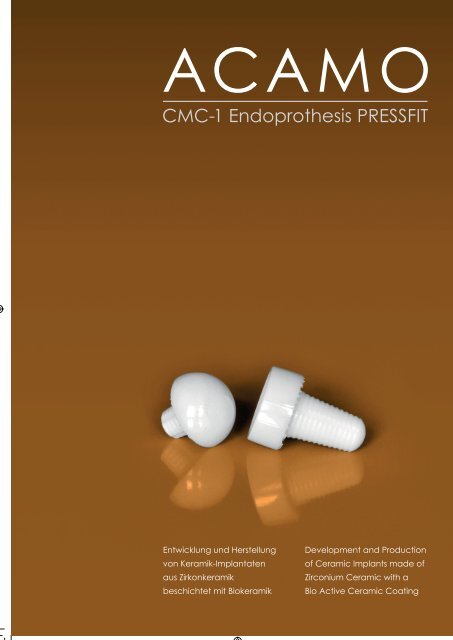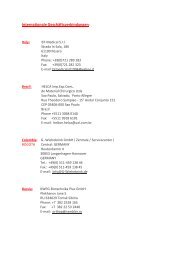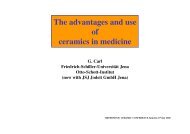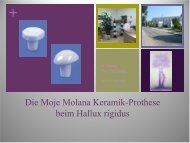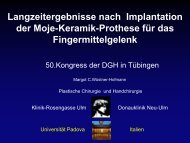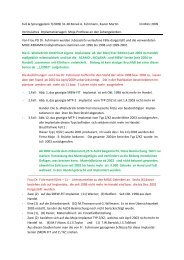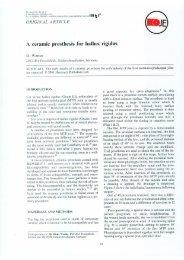Prospekt ACAMO CMC1 11_2010 - G.-Wiehebrink
Prospekt ACAMO CMC1 11_2010 - G.-Wiehebrink
Prospekt ACAMO CMC1 11_2010 - G.-Wiehebrink
Sie wollen auch ein ePaper? Erhöhen Sie die Reichweite Ihrer Titel.
YUMPU macht aus Druck-PDFs automatisch weboptimierte ePaper, die Google liebt.
<strong>Prospekt</strong> <strong>ACAMO</strong> <strong>CMC1</strong> <strong>11</strong>_<strong>2010</strong> 16.<strong>11</strong>.<strong>2010</strong> 9:19 Uhr Seite 2<br />
<strong>ACAMO</strong> CMC-1 Produkt und Material<br />
Product and Material<br />
Produkt<br />
Product<br />
Klinik<br />
Clinical Picture<br />
Material<br />
Material<br />
Die klinischen<br />
Vorteile:<br />
The Clinical<br />
Advantages:<br />
Osteoblasten-Morphologie auf Zirkondioxid<br />
Osteoblast morphology on zircon dioxide<br />
• Rasche Schmerzfreiheit<br />
• Wiederherstellung einer guten<br />
Kraft<br />
• Erhalt und Wiederherstellung<br />
der Beweglichkeit<br />
• Sehr gute Biokompatibitilität<br />
• Kein Abrieb<br />
• Zementlos<br />
• Einfache OP-Technik<br />
Osteoblasten-Morphologie auf Bioverit-beschichtetem Zirkondioxid<br />
Osteoblast morphology on Bioverit-coated zircon dioxide<br />
• Quick pain relief<br />
• Restoration of good strength<br />
• Maintenance and restoration<br />
of mobility<br />
• Very good biocompatibility<br />
• No abrasion<br />
• Cement-free<br />
• Simple OP-Technique
<strong>Prospekt</strong> <strong>ACAMO</strong> <strong>CMC1</strong> <strong>11</strong>_<strong>2010</strong> 16.<strong>11</strong>.<strong>2010</strong> 9:19 Uhr Seite 3<br />
<strong>ACAMO</strong> CMC-1 OP-Technik<br />
OP-Technique<br />
1 2 3 4 5<br />
Hautschnitt mit ca. 4 cm dorsoradialem Zugang.<br />
Skin incision with a dorsoradial access of approx. 4 cm<br />
6<br />
Überprüfen der Resektionstärke. Evtl.<br />
Nachresektion.<br />
Check the resection size. If necessary<br />
re-resection.<br />
<strong>11</strong><br />
Bohren bis zur zweiten Markierung.<br />
Drill to the second marking.<br />
Positionieren der Prothesenpfanne im<br />
MT 1.<br />
Position the socket of the prosthesis<br />
in MT 1.<br />
Setzen des K-Drathes 1,4 mm<br />
unter Bildwandlerkontrolle.<br />
Insert K-wire 1.4 mmand check<br />
positioning with an image intensifier.<br />
Implantatlager mit Fräsverdichter<br />
kompaktieren.<br />
Compact implant bed with a milling<br />
compactor.<br />
Impaktieren der Pfanne.<br />
Impact the socket.<br />
T-förmige Incision der Kapsel ca. 15mm ausgehend vom distalen Anteil des<br />
CMC-1 bis knapp über dem Gelenkspalt zum Trapezium.<br />
T-shaped incision of the capsule of approx. 15 mm starting from the distal<br />
portion of the CMC-1 to shortly above the joint space to the trapezium<br />
7 8 9 10<br />
Bohren bis zur ersten Markierung.<br />
Drill to the first marking.<br />
Gegebenenfalls mit nächst<br />
größerem Verdichter verdichten.<br />
If necessary, compact with the next<br />
biggest compactor.<br />
Reponieren des Gelenkes.<br />
Reposition the joint<br />
Kompaktieren des Prothesenlagers<br />
mit Spezialinstrument.<br />
Compact the prosthesis bed with a<br />
special instrument.<br />
12 13 14 15<br />
16 17 18 19<br />
Positionieren des Prothesenkopfes im<br />
Trapezium.<br />
Position the prosthesis head in the<br />
trapezium.<br />
Kapselnaht und anschliessend<br />
Hautnaht.<br />
Capsule suture followed by skin suture.<br />
Resektion des CMC-1 und der<br />
Trapeziumgelenkfläche (5+2mm)<br />
Resection of the CMC-1 and the joint<br />
surface of the trapezium (5+2mm)<br />
Setzen des K-Drahtes unter<br />
Bildwandlerkontrolle. (CMC-1)<br />
Insert K-wire with an image<br />
intensifier (CMC-1)<br />
Impaktieren der Prothese.<br />
Impact the prosthesis.
<strong>Prospekt</strong> <strong>ACAMO</strong> <strong>CMC1</strong> <strong>11</strong>_<strong>2010</strong> 16.<strong>11</strong>.<strong>2010</strong> 9:19 Uhr Seite 4<br />
<strong>ACAMO</strong> CMC-1 Indikation und Kontraindikation<br />
Indication and Contraindication<br />
Indikation:<br />
Indication:<br />
Kontraindikation:<br />
Contraindication:<br />
Postoperative<br />
Behandlung:<br />
Postoperative<br />
Treatment:<br />
• Rhizarthrose Trapeziometacarpal<br />
osteoarthritis<br />
• Sehr starke Subluxation<br />
• Trapeziumhöhe < 8 mm<br />
• STT - Athrose<br />
• Algodystrophie<br />
• Osteoporose<br />
• Mangelnde Compliance des<br />
Patienten<br />
• Starke körperliche Arbeit<br />
• Dystropher porotischer<br />
Knochen<br />
• Rheumatische Erkrankungen<br />
• Sport (z. B. Gewichtheben,<br />
Boxen, Tennis, Handball u. ä.)<br />
• 4 Wochen Gipsimmobilisation<br />
• 2 Wochen Ruhigstellung in<br />
einer CMC-1 Gelenksorthese<br />
• Physiotherapie<br />
• Freigabe nach 12 Wochen<br />
• Severe subluxation<br />
• Trapezial height < 8 mm<br />
• STT arthritis<br />
• Algodystrophy<br />
• Osteoporosis<br />
• Patient’s lack of compliance<br />
• Heavy physical work<br />
• Dystrophic porotic bone<br />
• Rheumatic diseases<br />
• Sports (e.g. weight lifting,<br />
boxing, tennis, handball, etc.)<br />
• 4 weeks immobilisation in<br />
a plaster splint<br />
• 2 weeks immobilisation in<br />
a CMC joint orthesis<br />
• Physiotherapy<br />
• Release after 12 weeks
<strong>Prospekt</strong> <strong>ACAMO</strong> <strong>CMC1</strong> <strong>11</strong>_<strong>2010</strong> 16.<strong>11</strong>.<strong>2010</strong> 9:19 Uhr Seite 5<br />
<strong>ACAMO</strong> CMC-1 Wichtige Hinweise<br />
Important Information<br />
Endoprothesen als<br />
Dauerimplantate sind dazu<br />
bestimmt, normale<br />
Körperstrukturen zu ersetzen.<br />
Bei der Verwendung von<br />
Implantaten sind nachstehende<br />
Punkte strikt zu beachten.<br />
Endoprostheses are intended<br />
for the replacement of normal<br />
body structures. When using<br />
implants, the surgeon should<br />
be aware of the following<br />
Wichtiger Hinweis über unsere Implantate:<br />
Endoprothesen als Dauerimplantate sind dazu<br />
bestimmt, normale Körperstrukturen zu ersetzen.<br />
Bei Verwendung von Implantaten ist<br />
Folgendes zu beachten.<br />
1. Die korrekte Auswahl des Implantates ist<br />
extrem wichtig.<br />
Die Erfolgschanzen des Eingriffs werden durch<br />
die richtige Implantatwahl ( Modell und Größe )<br />
wesentlich bestimmt. Größe und Form des<br />
menschlichen Knochens setzen der Form und<br />
Größe des Implantates Grenzen.<br />
Damit wird aber auch die Belastbarkeit<br />
begrenzt<br />
Implantate sind nicht dazu geeignet, die uneingeschränkte<br />
Körperbelastung zu tragen.<br />
Insbesondere Endoprothesen bedürfen einer<br />
besonders korrekten Implantation und Stützung<br />
durch den Knochen. Ihre Beanspruchung sollte<br />
mit der normalen funktionellen Belastung limitiert<br />
werden. Außergewöhnliche Belastungen,<br />
insbesondere verursacht durch Stoß- und<br />
Schlagkräfte, können zum Brechen der Keramik<br />
führen.<br />
2. Die korrekte Handhabung des Implantates<br />
ist äußerst wichtig.<br />
Ausschließlich die dafür vorgesehenen<br />
Instrumente dürfen zum Einbringen des<br />
Implantates verwendet werden. Das Implantat<br />
darf während der Operation unter keinen<br />
Umständen Schlägen mit harten Gegenständen<br />
ausgesetzt werden. Diese und ähnliche<br />
Handhabungen können die Struktur der<br />
Keramik verändern und unsichtbare Schäden<br />
verursachen, die zu einem späteren Brechen<br />
des Implantates führen können.<br />
3. Kein Implantat darf wiederverwendet oder<br />
vor Ort sterilisiert werden.<br />
Auch wenn das Implantat unbeschädigt aussieht,<br />
muss mit internen Materialermüdungen<br />
gerechnet werden. Auch dürfen keine unsteril<br />
gewordenen Implantate erneut sterilisiert werden,<br />
das kann zu Haarrissen führen. Wir weisen<br />
ausdrücklich darauf hin, nur fabrikneue, originalverpackte<br />
Implantate letzter Konstruktion zu<br />
verwenden.<br />
4. Die Nachbehandlung ist ebenfalls sehr<br />
wichtig.<br />
Der Patient muss auf die Grenzen der<br />
Belastbarkeit des Implantates hingewiesen werden.<br />
Die Belastbarkeit eines Implantates ist<br />
nicht mit der eines gesunden Knochens vergleichbar<br />
MOJE-KERAMIK IMPLANTATE Petersberg<br />
Ausführliche zu beachtende Kriterien sind auf<br />
Wunsch erhältlich. Dieser Katalog darf nur dem<br />
An- und Verkauf der von uns gelieferten<br />
Erzeugnisse dienen. Nachdruck, auch auszugsweise,<br />
ist verboten. Bei Missbrauch behalten<br />
wir uns Rücknahme der Kataloge und<br />
Preislisten sowie Regressmaßnahmen vor.<br />
Alle Instrumente sind, sofern nicht anders<br />
gekennzeichnet, aus rostfreiem Stahl hergestellt.<br />
Alle Implantate sind steril verpackt.<br />
Important information about our orthopaedic<br />
implants:<br />
Endoprostheses are intended for the replacement<br />
of normal body structures. When using<br />
implants, the surgeon should be aware of the<br />
following<br />
1. Selecting the correct implant is extremely<br />
important.<br />
The potential for successful surgery is greatly<br />
increased by selecting the proper type and size<br />
of implant. The size and shape of the human<br />
bone place restrictions on the size and shape of<br />
the implant, thus limiting its load-bearing capabilities.<br />
No implant can be expected to withstand<br />
the unsupported stress of full body<br />
weight. Endoprostheses are especially dependent<br />
upon proper placement and adequate<br />
bone support and should not be expected to<br />
withstand more than normal stresses and<br />
functional body weight.<br />
2. Correct handling of the implant is extremely<br />
important.<br />
During the operation the implant should under<br />
no circumstances be subjected to blows from<br />
hard objects. These and similar treatment can<br />
produce defects in the surface finish causing<br />
internal stress concentrations which may weaken<br />
the implant and lead to possible failure.<br />
Only the appropriate instruments should be<br />
used during the installation of the implant.<br />
3. No surgical implant should ever be reused<br />
or re-sterilised locally.<br />
Even if a previously used implant appears to be<br />
undamaged, it may already have developed<br />
internal fatigue which can lead to failure. We<br />
urge you to use only new implants of the latest<br />
design and construction.<br />
4. Post-operative care is important.<br />
The patient must be made aware of the limitations<br />
of his new implant. They must be cautioned<br />
that the new implant can only be expected to<br />
withstand limited stress until the supporting<br />
bones are completely healed. The load-bearing<br />
capability of implants cannot be compared to<br />
that of a healthy bone.<br />
MOJE – KERAMIK Petersberg<br />
Detailed information regarding important criteria<br />
can be supplied upon request.<br />
This catalogue was developed for the sale and<br />
promotion of our products described and illustrated<br />
herein. Reproduction of its contents, or<br />
any part thereof, is expressly prohibited. In the<br />
event of misuse, we reserve the right to reclaim<br />
both catalogue and price list as well as the right<br />
to recourse.<br />
All instruments, unless otherwise noted, are<br />
made of stainless steel.<br />
The implants are supplied in sterile packing.
<strong>Prospekt</strong> <strong>ACAMO</strong> <strong>CMC1</strong> <strong>11</strong>_<strong>2010</strong> 16.<strong>11</strong>.<strong>2010</strong> 9:19 Uhr Seite 6<br />
Clinical studies:<br />
Prof. NSMU. Dr. med. Joachim Felderhoff, MEVIVA, Center for Handsurgery, Berlin<br />
Dr. med. Michael Schönberger, Consultant Handsurgery, Bethel Hospital, Bückeburg<br />
Design;<br />
Prof. Dr. med. Abdul Kader Martini, Orthopaedic Department of Universyty of Heidelberg,<br />
Sektion Handsurgery.<br />
Anatomical advice:<br />
Prof. Dr. med. Andreas Prescher, Institute of Anatomy at the RWTH Aachen, University of Technology<br />
Biomechanical studies:<br />
Prof. Maja Bürgi,<br />
Züricher Hochschule für Angewandte Wissenschaften, School of engineering, CH-Wintherthur<br />
Design, Patents, Production, Certification<br />
Hans-Jürgen Moje, Petersberg (Thüringen) MOJE<br />
Reinhold <strong>Wiehebrink</strong> G.-<strong>Wiehebrink</strong> GmbH (Edewecht)<br />
Keramik-Implantate<br />
Herstellung: Vertrieb:<br />
Moje Keramik Implantate GmbH & Co.KG G.-<strong>Wiehebrink</strong> GmbH.<br />
Eschenweg 12 Deyehof 2 B<br />
D-07616 Petersberg D-26188 Edewecht<br />
www.moje.de Tel.: +49 (0) 4405 / 93 97 47<br />
Fax: +49 (0) 4405 / 93 97 48<br />
Implantat zertifiziert: g.-wiehebrink-gmbh@t-online.de<br />
www.g-wiehebrink.de<br />
1275<br />
last update <strong>11</strong>/<strong>2010</strong>


